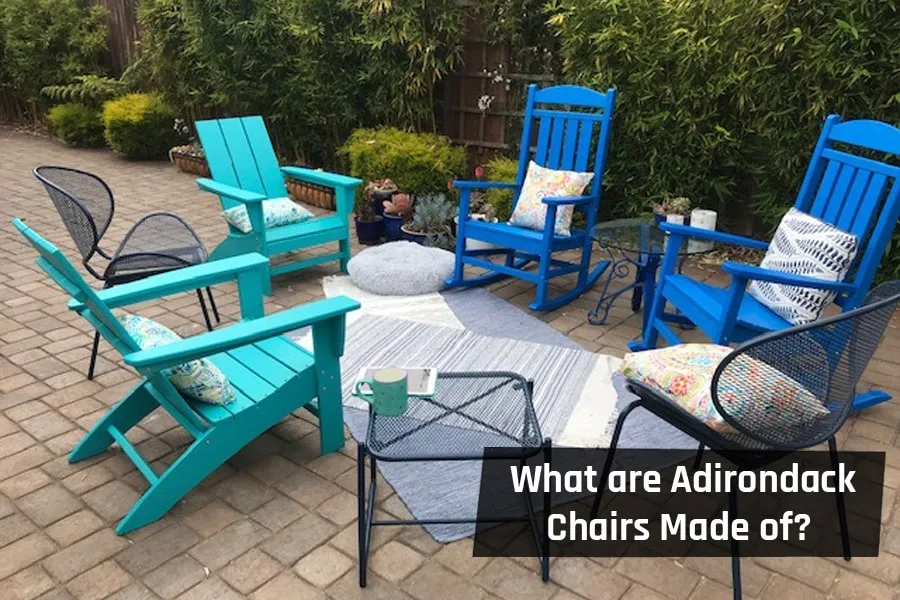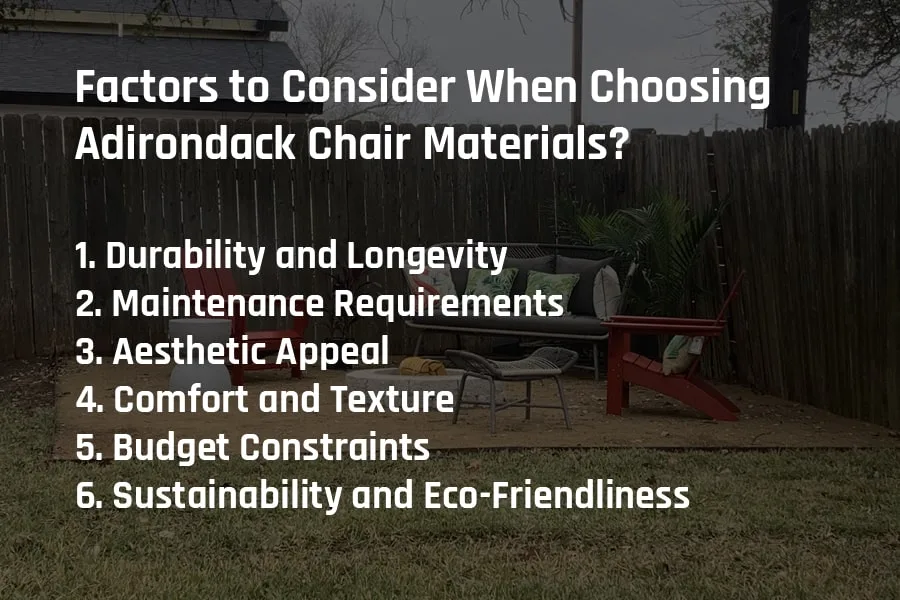When searching for top-quality materials to craft your furniture, particularly Adirondack chairs, you’ll encounter a variety of queries. You might feel overwhelmed by the query: what are adirondack chairs made of.
Adirondack chairs are typically made of wood, with cedar, teak, pine, or fir being popular choices due to their durability and resistance to outdoor elements. Some modern variations also use plastic, recycled materials, or composite materials to mimic the classic wooden look while offering enhanced longevity and reduced maintenance.
In this guide, you’ll discover prime options for outdoor Adirondack chair materials, coupled with additional useful insights you might find valuable.

What are Adirondack Chairs Made of?
Adirondack chairs can be crafted from a variety of materials to suit different preferences and needs.
Teak
Teak, a popular wood choice for outdoor furniture, seamlessly complements designs and surpasses other woods like pine, oak, or bamboo in weather resistance. Teak demands less upkeep compared to those woods.
However, it’s important to note that teak, despite its advantages, isn’t without imperfections.
Benefits
- Durability: Teak is renowned for its exceptional durability, making Adirondack chairs resistant to weather, pests, and decay.
- Natural Beauty: Teak’s rich, warm tones and natural grain patterns enhance the aesthetic appeal of the chairs, requiring minimal finishing.
- Low Maintenance: Teak’s natural oils repel moisture, reducing the need for frequent maintenance or sealing.
- Longevity: Teak Adirondack chairs can last for decades, making them a long-term investment for outdoor seating.
- Stability: Teak’s inherent stability helps the chairs resist warping and cracking, ensuring consistent comfort over time.
Drawback
- Cost: Teak Adirondack chairs tend to be more expensive due to the high-quality material, which can be a limiting factor for some budgets.
Aluminum
Aluminum, a lightweight metal, finds utility in furniture and household items. While it boasts durability, it isn’t a prevalent choice due to its relatively lower comfort and less preferred aesthetics.
Benefits
- Lightweight: Aluminum Adirondack chairs are easy to move and rearrange, providing flexibility for outdoor seating arrangements.
- Weather Resistance: Aluminum is highly resistant to rust and corrosion, making the chairs suitable for various weather conditions.
- Low Maintenance: The material’s resilience to the elements reduces the need for frequent upkeep or protective coatings.
- Modern Aesthetic: Aluminum’s sleek and contemporary appearance can complement a variety of outdoor settings and design styles.
- Longevity: Chairs made from aluminum can have a long lifespan due to their durability and resistance to wear and tear.
Drawback
- Cool Temperature: Aluminum chairs may feel cooler to the touch in chilly weather, potentially requiring additional cushions or padding for comfort.
HDPE Lumber
HDPE, known as high-density polyethylene lumber, stands out as the synthetic resin of choice for crafting robust outdoor furniture.
Furniture fashioned from HDPE boasts exceptional quality. Moreover, this material consistently yields comfortable, durable, and consequently luxurious pieces of furniture.
Benefits
- Environmental Friendly: HDPE lumber is often made from recycled plastic, reducing the demand for new materials and promoting sustainability.
- Weather Resistance: Chairs made from HDPE lumber are resistant to moisture, UV rays, and various weather conditions, ensuring durability.
- Low Maintenance: The material is easy to clean and doesn’t require painting, staining, or sealing, saving time and effort.
- Color Variety: HDPE lumber is available in a wide range of colors, allowing for customization and matching with outdoor decor.
- Long Lifespan: Adirondack chairs crafted from HDPE lumber can last for many years without deteriorating, contributing to their value.
Drawback
- Texture: HDPE lumber might have a slightly different texture compared to natural wood, which some individuals might prefer less for its tactile feel.
Injection Molded Plastic
Plastic choices frequently attract individuals for their outdoor furniture needs, primarily due to their comparatively affordable price.
While opting for plastic outdoor furniture is acceptable for the present, it’s important to emphasize that longevity and overall quality might be compromised over time.
Benefits
- Affordability: Injection molded plastic chairs are often more budget-friendly compared to other materials, making them accessible to a wide range of consumers.
- Low Maintenance: The material is resistant to stains, fading, and weather, requiring minimal upkeep and no painting or sealing.
- Lightweight: Plastic Adirondack chairs are lightweight and easy to move, allowing for convenient rearrangement and storage.
- Color Choices: Injection molding allows for a variety of color options, enabling customization to match outdoor aesthetics.
- Durability: These chairs can withstand outdoor conditions and resist cracking, warping, and rotting over time.
Drawback
- Aesthetic: Some people might find that injection molded plastic lacks the natural look and feel of wood, impacting the overall aesthetic appeal of the chairs.

What factors to Consider When Choosing Adirondack Chair Materials?
Choosing the right materials for your Adirondack chairs is crucial to ensure their longevity, comfort, and overall appeal in your outdoor space.
Several factors should be considered when making this decision, each influencing the chairs’ durability, maintenance, aesthetics, and budget. Here are some key factors to keep in mind:
Durability and Longevity
Select materials that can withstand outdoor conditions, such as weather, UV exposure, and moisture. Opt for options like teak, HDPE lumber, or aluminum, known for their durability and resistance to wear and tear.
Materials that resist rot, corrosion, and fading will ensure your chairs remain in excellent condition over time.
Maintenance Requirements
Consider how much maintenance you’re willing to invest in. Teak and HDPE lumber require minimal maintenance due to their natural oils and resistance to decay.
Aluminum and injection molded plastic chairs are also low-maintenance, as they don’t need staining, sealing, or frequent cleaning. Choose a material that aligns with your desired level of upkeep.
Aesthetic Appeal
The visual impact of your chairs plays a significant role. Teak offers timeless elegance with its natural grain and warm hues. HDPE lumber and injection molded plastic come in various colors, allowing customization to match your outdoor decor.
Aluminum chairs lend a modern touch to your space. Consider which material aligns with your preferred aesthetic.
Comfort and Texture
Think about the comfort and tactile feel of the chairs. Wood options like teak provide a classic, warm feel. HDPE lumber can be slightly different in texture compared to wood, and injection molded plastic may have a smoother surface.
Aluminum might feel cool to the touch in certain conditions. Test the comfort and texture of the materials before making a decision.
Budget Constraints
Your budget is a critical factor. Teak chairs tend to be more expensive due to the quality of the wood, while HDPE lumber, aluminum, and injection molded plastic options are often more budget-friendly.
Consider the balance between quality and cost that fits within your financial parameters.
Sustainability and Eco-Friendliness
If environmental considerations are important to you, opt for materials with sustainable attributes. HDPE lumber and some injection molded plastic chairs are made from recycled materials, contributing to waste reduction and a greener choice.
FAQ
Is wood or plastic better for Adirondack chairs?
Both wood and plastic have their advantages for Adirondack chairs. Wood, like teak, offers a classic look, while plastic, such as HDPE lumber, offers low maintenance and environmental benefits. The choice depends on aesthetics, maintenance preferences, and sustainability concerns.
Are plastic Adirondack chairs durable?
Yes, plastic Adirondack chairs, particularly those made from materials like HDPE lumber or injection-molded plastic, are durable. They resist weather, moisture, and fading, making them suitable for outdoor use. While not as traditional as wood, plastic options offer longevity and low maintenance benefits.
Final Notes
You can relish the enduring comfort and style of your Adirondack chair sans the need for staining, waterproofing, or repainting.
In summary, learning what are adirondack chairs made of involves evaluating pros and cons to match your requirements.
For our preference, robust, waterproof, and weather-resistant poly lumber emerges as the prime choice for Adirondack chair materials.
